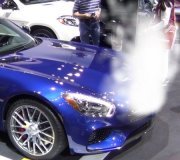This is typical of a leaking head gasket as you suspect. Usually all that's needed is a new gasket but the head must be checked too. Once in a while there will be a crack or the head could be warped. On older engines a warped head could be milled, ("surfaced"), to make it flat, but heads with overhead camshafts have to be heated and straightened, otherwise the warpage will leave the camshaft journals not in a straight line. If that warpage is bad enough it will make the camshaft bend with each revolution and can cause it to break. If the warpage is less than.002" for an aluminum head or.005" for a cast iron head, it won't need machining or straightening.
There are a number of tests to confirm it's the head gasket. First of all, if it appears to be overheating within a few minutes of starting a cold engine, you know it's not really that hot yet. The additional clue is while the coolant might be bubbling in the reservoir, there's no steam to go with those bubbles. The coolant in the reservoir will be cold yet too. It can't be boiling if it's cold so the bubbles have to be combustion gases.
The second test involves what I call the "sniffer" test. Air from the radiator is drawn through a glass cylinder with two chambers partially filled with a special dark blue liquid. If combustion gases are getting into the cooling system, the liquid will turn bright yellow.
You can add a small bottle of dye to the coolant, then drive the car for a few miles. If combustion gases can leak into the cooling system, coolant can leak into the combustion chamber and go out the exhaust. You search for the leak with a black light. The dye will show up as a bright yellow stain that you can follow back to the leak. In the case of a head gasket, you'll find the bright yellow inside the tail pipe.
You can perform a cylinder leakage test to confirm a leak and identify the defective cylinder. It's similar to performing a compression test, but instead of cranking the engine to build pressure, you place each piston at top dead center, one at a time, on the compression stroke, then pump in compressed air through a regulator and gauge. The gauge will show the percent of leakage and you can check four places for the results. If you hear air hissing at the tail pipe, the exhaust valve is leaking. Hissing at the intake / throttle body / carburetor is from a leaking intake valve. Hissing at the oil cap or dipstick tube, leaking past the piston rings, and bubbling in the radiator, leaking head gasket or cracked head.
By knowing which cylinder is creating the problem, you cut way down on the places to look once you have the head gasket in your hand. If you absolutely can't find a spot where it is corroded through, then you have to check the head very closely. Some cracks are hard to see without special equipment and chemicals but you don't want to overlook one and have the same problem when the new head gasket is installed.
SPONSORED LINKS
Saturday, May 7th, 2011 AT 4:23 AM



